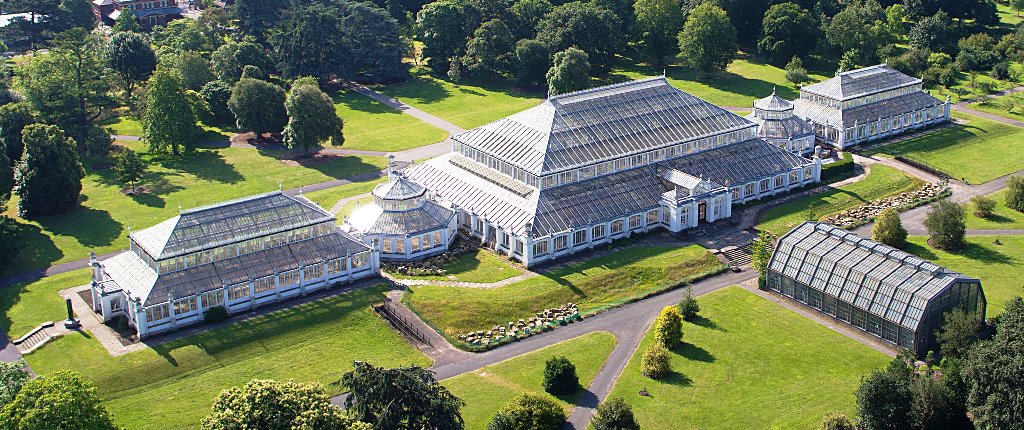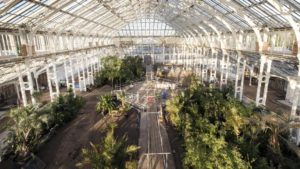In May of 2018 in London, England, Kew Gardens completed the largest restoration project in its entire history, and the doors of its spectacular Temperate House opened again after five years of renewal. Inside were 10,000 breathtaking plants, making this magnificent structure the true jewel in Kew’s crown – an architectural wonder, a horticulturists’ haven and the most captivating of classrooms.
The Royal Botanic Gardens project involved 400 staff and contractors, and took 1,731 days to complete. 69,000 individual elements removed from building and cleaned, repaired or replaced. The restoration made possible by support of nearly £15 million from the National Lottery, as well as contributions from Defra and other corporate and private donors.
Aimée Felton, lead architect on the project, said: “The restoration of the Temperate House has been a complex and immensely rewarding project, recalibrating contemporary understanding of Victorian architecture and the development of past innovations. New glazing, mechanical ventilation systems, path and bedding arrangements all took their founding principles from Decimus Burton’s own drawings, held within Kew’s archives.”
The world’s largest Victorian glasshouse, the Temperate House first opened in 1863, and will now be home to some of the world’s rarest and most threatened plants. In contrast to their sumptuous, romantic surroundings, these plants present a stark message; despite being the foundation of pretty much all life on earth, we are allowing them to fall prey to a variety of threats.
Lord Gardiner, Minister for Kew said: “Kew is recognised worldwide for its scientific prowess. It is also one of the world’s most iconic botanical gardens, home to a unique collection of flora and at the cutting edge of conservation, disease and climate change research. I am delighted to see the Temperate House restored to an exceptional standard. It will amaze and inspire new generations of visitors with its outstanding architecture and abundance of plant life.”
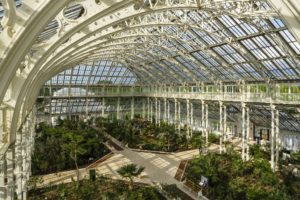 When the last plant of a particular species dies out, what might it take with it? A new cure for Cancer? Or Ebola? The Temperate House tells the stories of the plants that Kew has rescued, and the journeys they have taken to reach the sanctuary of their new home.
When the last plant of a particular species dies out, what might it take with it? A new cure for Cancer? Or Ebola? The Temperate House tells the stories of the plants that Kew has rescued, and the journeys they have taken to reach the sanctuary of their new home.
Speaking to the BBC on May 3, Sir David Attenborough spoke of his delight with the restoration ahead of the evening event at which he officially opened the magnificent Temperate House. He said: “(It is) a breathtakingly beautiful space. These plants are wonderful…(and here they are) safe from peril.”
Speaking of Kew as a global reference point, Sir David said: “Kew does all sorts of things that nowhere else does. If you want to identify something, this is the ultimate authority worldwide. It’s the most important botanical institute in the world…Kew occupies a very special place in the science of Botany. In some circumstances, the only way you can prove that a particular species is that species, is to come to Kew and compare what you have with what is here. This is why people come from all over the world to the Kew Herbarium, and to these great glasshouses. When I had an office job…I used to come to Kew at weekends when I was depressed, and take deep breaths…it’s lovely.”
Entering the glasshouse, visitors will embark on a round-the-world adventure. They might find themselves in South Africa, where they will see the cycad Encephalartos woodii, the famous ‘loneliest tree in the world’. Its Jurassic appearance helped it to withstand the nibbles of prehistoric predators but now only male specimens exist and the quest for a female has been unsuccessful.
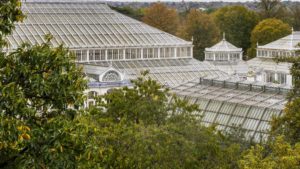 Another treasure is the Dombeya mauritiana tree, thought to be extinct in the wild until Kew’s Carlos Magdalena found one growing in the highlands of Mauritius. After trials and tribulations (including forming a human ladder to reach the lowest branch!), Carlos was able to gather and return with cuttings, and Kew is now the only place in the world with this tree in cultivation.
Another treasure is the Dombeya mauritiana tree, thought to be extinct in the wild until Kew’s Carlos Magdalena found one growing in the highlands of Mauritius. After trials and tribulations (including forming a human ladder to reach the lowest branch!), Carlos was able to gather and return with cuttings, and Kew is now the only place in the world with this tree in cultivation.
Around the corner, from the mountains of Nepal, visitors will encounter the Taxus wallichiana, exploited for the Taxol market (a chemotherapy drug) and now subject to a clonal propagation program to help conserve it in the wild.
Richard Barley, Director of Horticulture at RBG Kew, says: “It’s been amazing watching this project unfold, the building emerge gloriously and some of the world’s rarest plants safely reach their home. This is world class horticulture, science and design working together to create something truly impressive. The Temperate House is a glistening cathedral where the new glass allows the sun to stream in and the ironwork has been restored to its glossy best. And I’m most excited that it is for everyone, from young to old, for budding gardeners or aspiring artists, for those making a pilgrimage from great distances, and for our local community, we hope every visitor will see plants in a new light.”
The Royal Botanic Gardens, Kew is a world famous scientific organisation, internationally respected for its outstanding collections as well as its scientific expertise in plant diversity, conservation and sustainable development in the UK and around the world. Kew Gardens is a major international and a top London visitor attraction.
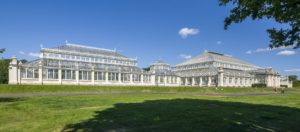 Kew’s 132 hectares of landscaped gardens, and Kew’s country estate, Wakehurst, attract over 2.1 million visits every year. Kew was made a UNESCO World Heritage Site in July 2003 and celebrated its 250th anniversary in 2009. Wakehurst is home to Kew’s Millennium Seed Bank, the largest wild plant seed bank in the world.
Kew’s 132 hectares of landscaped gardens, and Kew’s country estate, Wakehurst, attract over 2.1 million visits every year. Kew was made a UNESCO World Heritage Site in July 2003 and celebrated its 250th anniversary in 2009. Wakehurst is home to Kew’s Millennium Seed Bank, the largest wild plant seed bank in the world.
Kew receives approximately just under half of its funding from Government through the Department for the Environment, Food and Rural Affairs (Defra) and research councils. Further funding needed to support Kew’s vital work comes from donors, membership and commercial activity including ticket sales.
All images courtesy of Gareth-Gardner / Royal Botanic Gardens, Kew.

